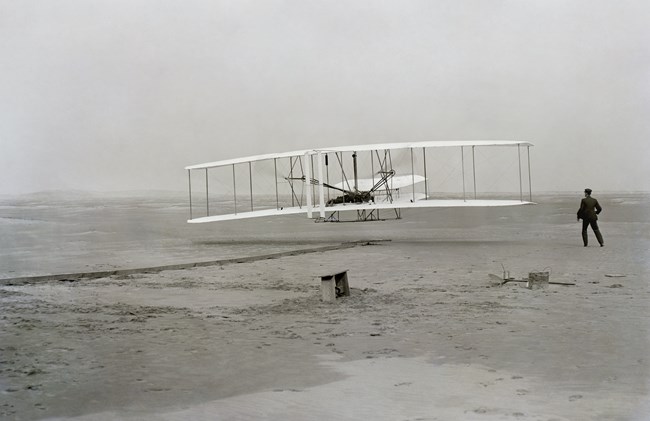Part of a series of articles titled Curiosity Kit: American Aviation History .
Article
Learning From Aviation Technology Innovation

Background:
From the Wright Brothers’ first military airplane in 1908 to experiments with airships, from rocket missile tests to spacecraft, the history of aviation is one of continuous innovation. Trial and error made aircraft, and eventually spacecraft, faster, safer, and more durable. These innovations brought changes to the ways in which the military and civilians use and rely on airplanes. It would’ve been almost impossible for early inventors of airplanes to imagine today’s passenger planes or space shuttles! You can learn more about historic airfields and tests sites through the Travel Sites of American Aviation website.
Objectives:
-
Learn about aviation innovation through hands-on design challenges.
-
Explore ways through which technology is improved through testing and iteration.
-
Use both scientific and creative thinking to design your own airplane or spacecraft.
Inquiry Question:
How does changing technology affect the way we live?
Activity One:
Throughout the 1900s, inventors and engineers worked to design airplanes that could travel long distances very quickly. One way they did that was by decreasing drag. Drag affects how far an airplane can fly by slowing it down. We can see how that happens on paper airplanes: when there is too much drag, paper airplanes more slower and only travel short distances. When drag is decreased, paper airplanes can fly faster and further. The same is true with real airplanes! In this activity, you will design and test three different airplane designs to decide which design will let your plane fly the fastest and furthest.
First, design your paper airplane. Test it three times by throwing it in the same direction with the same force. Mark how far your airplane goes each time.
Second, based on how your paper airplane flew, redesign your airplane to make it fly further. Think about how you can change the shape or the materials you are using. Then, test your new design using the same steps as above.
Third, redesign for the final time, and test your final design with the same steps as above.
After you test your three designs, think about the following questions:
-
Which version of your airplane went the furthest?
-
What was different in the way the three versions flew or moved through the air?
-
What was your thought process as you redesigned your airplanes?
-
How would you change your paper airplane design in the future to make it go further?
Activity Two:
From World War II onwards, aviation innovation began to focus on rockets, missiles, and spacecraft. At sites such as White Sands, Cape Canaveral, the Rocket Propulsion Test Complex, and the John F Kennedy Space Center, generations of rockets were tested. Now, it’s your turn to test your own rocket. You’ll need paper, tape, a pencil, and a soda straw. This activity is inspired by the Jet Propulsion Laboratory’s Soda-Straw Rockets Lesson Plan which you can check out for rocket design ideas and extension activities.
First, design what your rocket will look like. Will it have a cone top? How long will its body be? Will it have fins? If so, how many?
Second, build your rocket. Make sure the body of your rocket wraps around the pencil so that it is hollow. When you are done designing your rocket, remove the pencil, and replace it with the soda straw.
To launch your rocket, blow into the soda straw.
After designing your rocket, launch it at least three times, marking down how far it goes each time. Once you have tested your initial rocket design, it is time to redesign! What could make your rocket go further or straighter? What has been damaged in your initial tests that you need to make stronger? Can you make your rocket lighter or heavier?
Once you redesign, make sure to test it again. Mark down how far it goes each time. How does its flight compare to your initial design?
After you test your second iteration, redesign and test your rocket one last time, taking into account what you’ve learned so far.
Once you’ve completed your tests, consider the following questions:
-
Which rocket design flew the furthest? Which flew the straightest?
-
Which rocket was the best? How did you decide that?
-
How did your redesigns affect how your rocket flew?
-
Why did you choose to change the design the way you did?
-
What would you change in a future design of your rocket?
Activity Three:
During World War II, the practice of adding “nose art” to airplanes caught the imagination of aviators and their flight crews everywhere. Amateur artists painted women, Disney characters, cartoon characters and song motifs onto the noses of their planes. This artwork often meant something special to pilots, or was meant to cheer them up. If you had a plane, what would you paint on it? As you design your artwork, consider the following questions:
-
What kind of plane are you painting? What kind of job is it used for?
-
Are there artists in your community whose artwork you admire? What elements of their artwork can you use for inspiration?
-
Do you have a movie, TV, or book character you especially admire?
-
Who from you community or family might you honor with your artwork?
-
What kind of message do you want to send with your artwork? How can symbols or color palettes help send that message?
Tags
- airplane
- flight
- science and technology
- engineering
- early 20th century
- mid 20th century
- world war ii
- educational activity
- teaching with historic places
- twhp
- curiosity kit
- transportation
- late 20th century
- wright brothers
- military history
- airplane mechanics
- airplanes
- technology
- space exploration
- aviation
- aviation history
- virginia
- virginia history
- twhplp
Last updated: March 30, 2023
